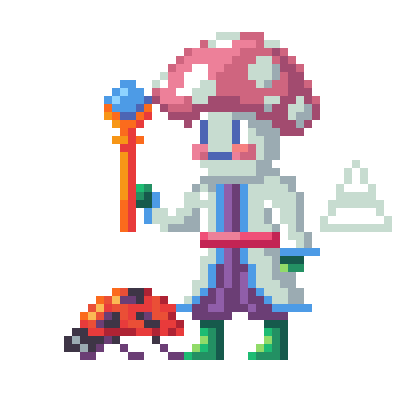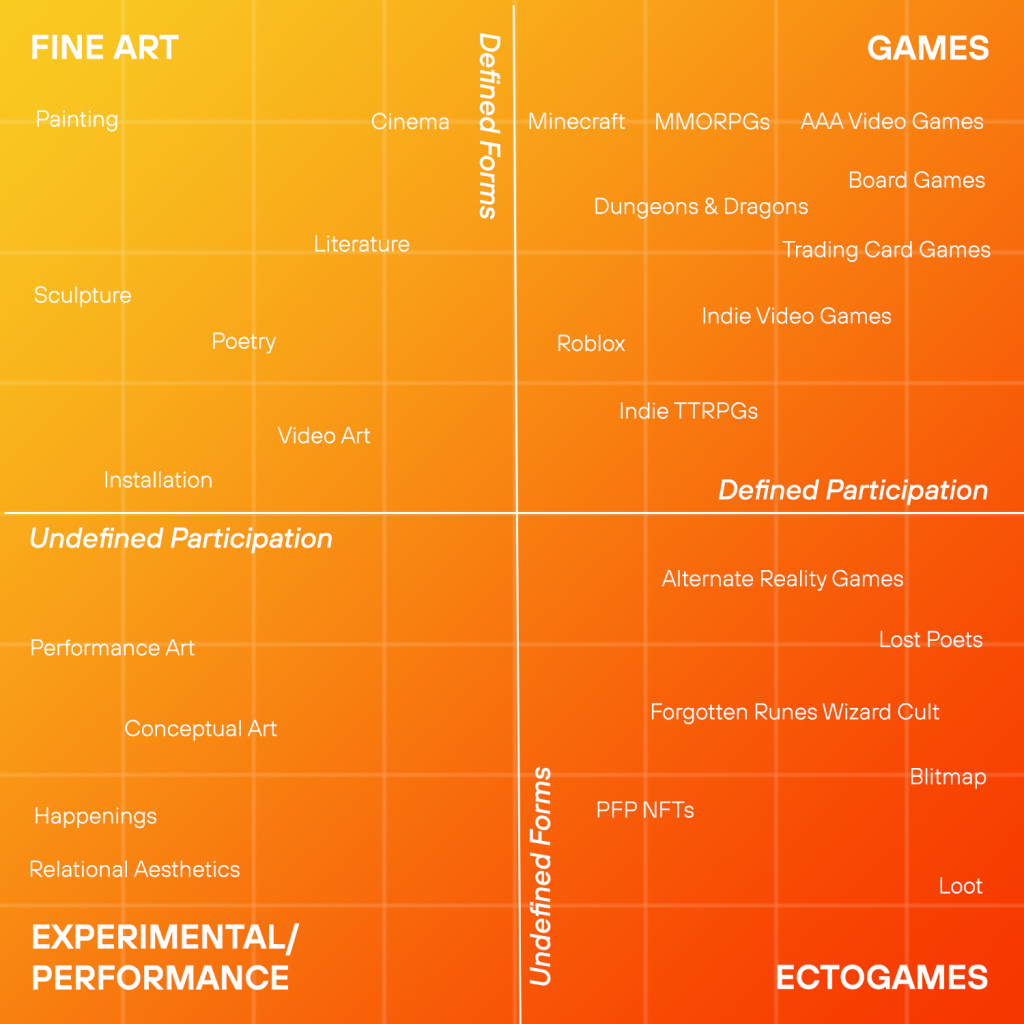Artists on Games
Mitchell F. Chan interviews artists to understand how games have influenced their work.

One frustrating thing about the discourse around NFTs is that so many people think they’re inventing things that already exist: dematerialized art objects, certificates of authenticity, contracts as artworks, collectable digital art. None of these are new. Blockchain technology, on the other hand, is relatively new, and the current amount of attention, speculation, and experimentation around digital art is certainly new. With a kernel of novel technology and lots of creative riffing, a genuinely new cultural form could be emerging. Consider the interplay between two well-established cultural forms that have provided use cases for NFTs: art and games. These two spheres have overlapped before, but NFTs have become the basis for novel combinations of art and play that could be called “ectogames,” ecto- here meaning outer, external. Ectogames are NFT projects that offer elements of games—characters, gear, fictional settings, lore, strategy, and even player communities—but lack the organizing form of a game. Ectogames have some distant pre-blockchain antecedents, but they’re largely an emergent phenomenon of recent NFT activity. Ectogames are not gamification—the imposition of game logic onto non-game activities. Rather, ectogames are what happens when the elements and behaviors we know from games move into new territory and coalesce into something else.



The market for digital art and collectibles dominates a lot of the discussion around NFTs, particularly from those of us with art world experience. But if something truly new is emerging, then to recognize it we need to think beyond how blockchains can energize and streamline markets for digital art. Similarly, there are games that use blockchains to introduce ways for players to share ownership of the game world, such as The Sandbox, Litebringer, and Axie Infinity among many others. But these are not ectogames.
Ectogames are what happens when the elements and behaviors we know from games move into a new territory and coalesce into something else.
Digital art and computer games can integrate blockchain technology or be sold on blockchain exchanges without challenging our understanding of art or games as cultural forms. Games, as we know them now, are structured play. They offer frameworks that connect many elements, which can include characters, depictions of objects and actions, imagined worlds, as well as rules that govern the interactions of these elements and the potential actions of players. This understanding of games accounts for everything from chess to Pokémon cards to the Call of Duty franchise. Ectogames, on the other hand, invert the logic of the game. They have some of the aforementioned game elements but no unifying framework that structures play.


A two-by-two matrix can be used to illustrate how art, games, and this emerging form of ectogames relate to each other. The y-axis describes how structured and specific the formal, conceptual, and historical qualities of a cultural artifact or activity tend to be, ranging from “undefined forms” at the bottom to “defined forms” at the top. The x-axis charts how clear the role of the audience/viewer/player is in relation to the artifact or activity, on a spectrum from “undefined participation“ on the left to “defined participation” on the right. The y-axis is concerned with what the cultural form is, while the x-axis is concerned with what one does with it. This results in four quadrants. In the quadrant of “defined forms / undefined participation” on the upper left we find fine art like painting and sculpture. The form of these artifacts is clearly defined, but how the viewer participates is ambiguous. There are no instructions. You decide when you’re done. There is no way to “win” looking at a painting.
The upper right quadrant, “defined forms / defined participation,” is where we find games as we know them. Games follow established structures with well-defined internal logic. The possibilities for a player’s interaction with a game are often narrowly defined. Board games come with a set of rules. Video games only allow certain character actions. Both have clearly established goals and limits. The bottom left quadrant, “undefined forms / undefined participation,” is where we find experimental artistic practices like happenings, social sculpture, and relational artworks. What form an artifact or activity should take here is unbound by tradition, and the audience’s role is similarly open to possibility; it may or may not involve participation. Finally, the bottom right quadrant is where we find “defined participation / undefined forms”—the new ectogames. Participants in ectogames behave like players in a game. They develop characters, claim loot, form communities, and even collaborate on lore, fan art, maps, and other user-generated content that typically stems from an established game, all without the structure of a game.

In some cases ectogames are works in progress, like Blitmap, a “community crafted sci-fantasy universe,” that began with on-chain pixel art that then expanded into collectable characters called Blitnauts. Loot (for Adventurers) consists of eight thousand NFTs, each a randomized list of fantasy gear. Starting from this deceptively simple series of collectables—black squares with white text listing the sort of items in a Dungeons & Dragons character’s inventory—users built words around it, complete with art, lore, and dozens of compatible spin-off projects. Both Blitmap and Loot are the work of Dom Hofmann, co-creator of Vine. Hofmann is prolific, but he’s not the only one forging new ground in this space. Lost Poets by Pak is a still-evolving NFT collectible and strategy ectogame forming over a series of acts. Forgotten Runes Wizard Cult by Elf and Dotta is a collection of ten thousand pixel art wizards, buoyed by a community that’s feverishly writing lore and roleplaying adventures in chat rooms. Casting the parameters of ectogames a bit wider, we could claim that all profile picture (PFP) NFT series—such as Cryptopunks, Bored Apes, and Cryptoadz—also resemble these boundless games. Players/collectors take on the roles of characters, form communities, and actively or passively wait for the structure of the game to become clearer.
The future-oriented attitude of people investing in NFTs lends itself well to acquiring game elements that exist outside game frameworks—as does a willingness to speculate.
The bulk of the NFT market, and most ectogames, are currently on the Ethereum blockchain. Unlike Bitcoin, Ethereum was designed to be more than a distributed ledger for digital currency. Ethereum, and other blockchains like it, can hold and exchange more complex tokens and smart contracts that execute functions with code. NFTs are often criticized for not being actual art objects, but rather mere certificates pointing to image files saved somewhere else. Although this is true for most NFTs, the potential exists for smart contracts to do much more, such as creating generative art through code and operating as dynamic game elements. The NFTs that make up Blitmap, Lost Poets, and Forgotten Runes Wizard’s Cult are subject to various transformations as narratives evolve and fictional worlds are fleshed out.

Ectogames are emerging from the flurry of experimentation and speculation in the NFT space. Blockchain technology may or may not be a prerequisite for them. But the future-oriented attitude of people investing in NFTs lends itself well to acquiring game elements that exist outside game frameworks—as does a willingness to speculate. Participants in ectogames are all betting that a game, or something like it, will form around the elements they own, and that those elements will hold or gain value while that happens. While true ectogames are a small subset of the overall NFT market, they capture the spirit of the whole scene, and they may offer a clearer picture of where things are headed than the sale of jpegs might. Everyone purchasing NFTs, from digital art collectors to DeFi bros buying their way into the Bored Ape Yacht Club, are all making the same bet: that a new game, a new way of existing and making money on the internet, will form around them and they’ll own a piece of it. There is no guarantee that will happen. It’s hard to bet wisely when no one tells you the odds, and there’s no way to calculate the odds when the game doesn’t exist.
Kevin Buist is a design strategist, curator, and writer based in Grand Rapids, Michigan.
